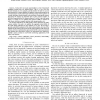Free Online Productivity Tools
i2Speak
i2Symbol
i2OCR
iTex2Img
iWeb2Print
iWeb2Shot
i2Type
iPdf2Split
iPdf2Merge
i2Bopomofo
i2Arabic
i2Style
i2Image
i2PDF
iLatex2Rtf
Sci2ools
JIRS
2007
2007
Optimal Camera Placement for Automated Surveillance Tasks
— Today, there are many opportunities to create vision-based intelligent systems that are human-centric. This is a very rich area because humans are very complex, and the number of tasks we can use these systems for is almost limitless. In addition, camera placement has an enormous impact on the performance of human-centric vision systems. As a result, this paper focuses largely on the problem of task-specific camera placement. We attempt to determine how to place cameras relative to activities being performed by human subjects, in order to provide image input to a system so as to optimize that system’s ability to achieve its task (learn activities, recognize motion, take measurements, etc.). We develop methods for the task-specific camera placement of multicamera systems. Our goal is to optimize the aggregate observability of the tasks being performed by the subjects in an area. We develop a general analytical formulation of the observation problem, in terms of the statistics of...
| Added | 15 Dec 2010 |
| Updated | 15 Dec 2010 |
| Type | Journal |
| Year | 2007 |
| Where | JIRS |
| Authors | Robert Bodor, Andrew Drenner, Paul R. Schrater, Nikolaos Papanikolopoulos |
Comments (0)

